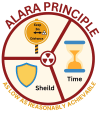An Overview of Appropriate Medical Practice and Preparedness in Radiation Emergency Response
- PMID: 38966480
- PMCID: PMC11222772
- DOI: 10.7759/cureus.61627
An Overview of Appropriate Medical Practice and Preparedness in Radiation Emergency Response
Abstract
Radiation emergencies involving high doses of nuclear radiation pose significant risks from exposure to ionizing radiation in various scenarios. These situations include transportation accidents involving radioactive materials, occupational exposure, nuclear detonations, dirty bombs, and nuclear power plant accidents. In addition to the immediate risks of acute radiation syndrome (ARS) and related diseases, long-term exposure can increase the risk of other health issues such as cardiovascular disease and cancer. Vulnerable populations, including pregnant women and children, face particular concern due to potential impacts on their health and the health of unborn babies. The severity of ARS depends on several factors such as radiation dose, quality, dose rate, exposure uniformity, and individual biological responses. Bioindicators are biological responses or markers that help assess the severity and effects of radiation exposure on an individual. Bioindicators can include physical symptoms such as nausea, vomiting, and diarrhea, or laboratory tests such as changes in blood cell counts and gene expression that can help in assessing and treating exposed individuals. Additionally, early prodromal symptoms such as vomiting, diarrhea, and erythema can provide important clues for diagnosis and treatment. Developing a comprehensive plan for radiation emergencies is vital for safeguarding public health, infrastructure, and the environment. First responders play a critical role in establishing safety perimeters, triage, and coordination with various stakeholders. Education and training are essential for medical personnel and the public. This article provides general recommendations and identifies challenges to effective radiation emergency preparedness and response.
Keywords: contamination; preparedness; public health; radiation emergency; radiation medicine; radiation practices.
Copyright © 2024, Al-Ibraheem et al.
Conflict of interest statement
Conflicts of interest: In compliance with the ICMJE uniform disclosure form, all authors declare the following: Payment/services info: All authors have declared that no financial support was received from any organization for the submitted work. Financial relationships: All authors have declared that they have no financial relationships at present or within the previous three years with any organizations that might have an interest in the submitted work. Other relationships: All authors have declared that there are no other relationships or activities that could appear to have influenced the submitted work.
Figures




Similar articles
-
Emergency Response to Radiological Releases: Have We Communicated Effectively to the First Responder Communities to Prepare Them to Safely Manage These Incidents?Health Phys. 2018 Feb;114(2):208-213. doi: 10.1097/HP.0000000000000757. Health Phys. 2018. PMID: 30086017
-
OSHA Bloodborne Pathogen Standards.2023 Jul 20. In: StatPearls [Internet]. Treasure Island (FL): StatPearls Publishing; 2025 Jan–. 2023 Jul 20. In: StatPearls [Internet]. Treasure Island (FL): StatPearls Publishing; 2025 Jan–. PMID: 34033323 Free Books & Documents.
-
Folic acid supplementation and malaria susceptibility and severity among people taking antifolate antimalarial drugs in endemic areas.Cochrane Database Syst Rev. 2022 Feb 1;2(2022):CD014217. doi: 10.1002/14651858.CD014217. Cochrane Database Syst Rev. 2022. PMID: 36321557 Free PMC article.
-
[Standard technical specifications for methacholine chloride (Methacholine) bronchial challenge test (2023)].Zhonghua Jie He He Hu Xi Za Zhi. 2024 Feb 12;47(2):101-119. doi: 10.3760/cma.j.cn112147-20231019-00247. Zhonghua Jie He He Hu Xi Za Zhi. 2024. PMID: 38309959 Chinese.
-
Awareness and preparedness level of medical workers for radiation and nuclear emergency response.Front Public Health. 2024 Jun 17;12:1410722. doi: 10.3389/fpubh.2024.1410722. eCollection 2024. Front Public Health. 2024. PMID: 38952739 Free PMC article. Review.
Cited by
-
A Destroyer of Tissues: A Case of Chronic Low-Dose Radiation Exposure and the Need for Frequent Screening in Exposed Populations.Cureus. 2024 Nov 1;16(11):e72845. doi: 10.7759/cureus.72845. eCollection 2024 Nov. Cureus. 2024. PMID: 39618768 Free PMC article.
References
Publication types
Grants and funding
LinkOut - more resources
Full Text Sources
